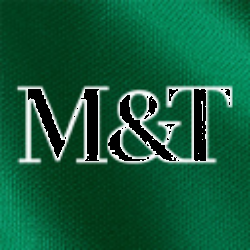Overall, M&T Bank displays a strong business model with a commitment to community and customer relationships, leading to improved asset quality. However, it faces challenges with margin pressure and uncertainty in loan demand. Future prospects appear solid with targeted market expansions and a positive economic outlook.
Analysis Date: January 16, 2025
Last Updated: April 12, 2025
Trailing Twelve Months (TTM) values provide a view of the company's performance over the last year.
Graham Value Metrics
Benjamin Graham's value investing approach focuses on finding stocks with a significant margin of safety between their intrinsic value and market price.
Intrinsic Value
Estimated fair value based on Graham's formula
$194.09
Current Market Price: $154.78
IV/P Ratio: 1.25x (>1.0 indicates undervalued)
Margin of Safety
Gap between intrinsic value and market price
20.0%
Graham recommended a minimum of 20-30% margin of safety
Higher values indicate a greater potential discount to fair value
ROE: 9.121026291675477
ROA: 0.3272386535643065
Gross Profit Margin: 100.0
Net Profit Margin: 22.71769662921348
Trailing Twelve Months (TTM) values provide a view of the company's performance over the last year.
Strong Net Profit Margin
MTB shows a net profit margin of 22.72%, indicating that the company retains a significant portion of revenue as profit, which is a sign of strong operational efficiency.
Good Return on Equity
With a return on equity of 9.12%, MTB demonstrates effective use of shareholders' equity to generate profits, which is a positive indicator for investors.
Moderate Operating Profit Margin
22.41%
Operating Profit Margin
The operating profit margin of 22.41% is solid but not exceptional, suggesting that while the company is profitable, there may be room for operational improvements.
About Profitability Metrics
Profitability metrics measure a company's ability to generate earnings relative to its revenue, operating costs, and other relevant metrics. Higher values generally indicate better performance.
Return on Equity (ROE)
Measures how efficiently a company uses its equity to generate profits
9.12%
10%
15%
Higher values indicate better returns for shareholders
TTM (as of 2025-04-16)
Return on Assets (ROA)
Measures how efficiently a company uses its assets to generate profits
0.33%
3%
7%
Higher values indicate better asset utilization
TTM (as of 2025-04-16)
Gross Profit Margin
Percentage of revenue retained after accounting for cost of goods sold
100.00%
20%
40%
Higher values indicate better efficiency in production
TTM (as of 2025-04-16)
Net Profit Margin
Percentage of revenue retained after accounting for all expenses
22.72%
8%
15%
Higher values indicate better overall profitability
TTM (as of 2025-04-16)
Excellent Liquidity Ratios
MTB has a current ratio of 599.33 and a quick ratio of 599.33, indicating exceptional liquidity and the ability to cover short-term obligations without financial strain.
Low Debt Levels
0.47
Debt-to-Equity Ratio
0.07
Debt-to-Assets Ratio
With a debt-to-equity ratio of 0.47 and debt-to-assets ratio of 0.07, MTB maintains a low level of debt, which suggests financial stability and lower risk.
Low Interest Coverage
0.61
Interest Coverage Ratio
The interest coverage ratio of 0.61 indicates that MTB may have difficulty covering its interest expenses, which could be a concern for future financial stability.
About Financial Health Metrics
Financial health metrics assess a company's ability to meet its financial obligations and its overall financial stability.
Debt to Equity Ratio
Total debt divided by total equity
0.47x
1.0x
2.0x
Lower values indicate less financial leverage and risk
Less than 1.0 is conservative, 1.0-2.0 is moderate, >2.0 indicates high risk
Q4 2024
Current Ratio
Current assets divided by current liabilities
35.96x
1.0x
2.0x
Higher values indicate better short-term liquidity
Less than 1.0 is concerning, 1.0-2.0 is adequate, greater than 2.0 is good
Q4 2024


